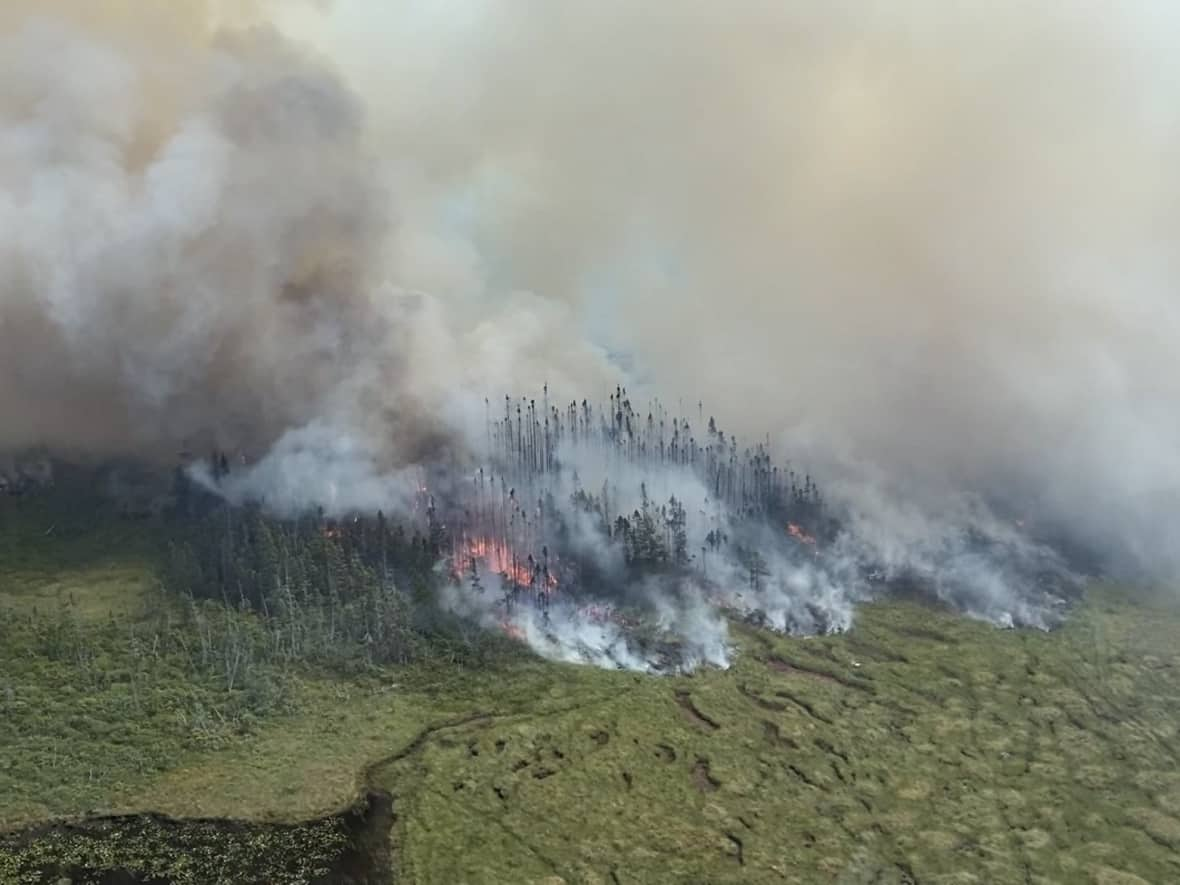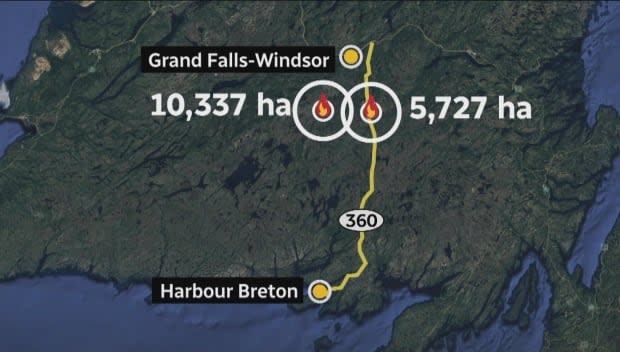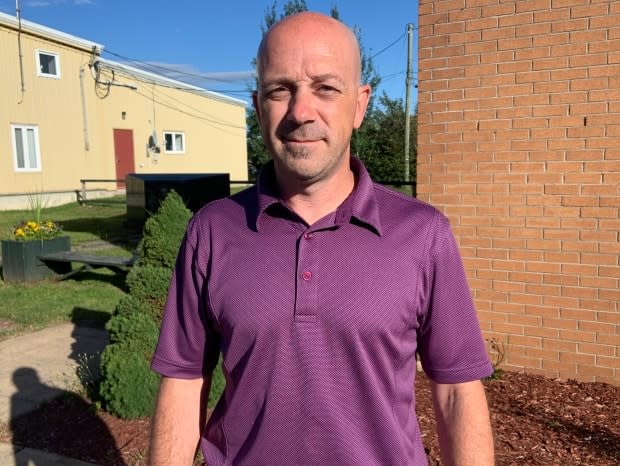Major highway reopens to cut-off Newfoundland communities, as forest fires continue to rage

A critical road link into Newfoundland's Coast of Bays region will stay open overnight Tuesday.
In a news release sent Tuesday evening, the province said the Bay d'Espoir Highway will stay open, but drivers should "note that overnight visibility may be reduced and residents should drive carefully."
"This decision will be reassessed in the morning as weather and visibility conditions could change," said the release.
Forest roads along the highway are still closed, and the province said cabin owners should not enter the area.
Route 360 reopened midday Tuesday, after the province closed it for days amid two persistent wildfires that have kept more than 20,000 people under a state of emergency since Saturday.
A combination of rain, changing winds and a battery of firefighting strategies have dampened the flames enough to permit traffic along the Bay d'Espoir Highway, allowing food and other goods into the stranded communities in the Coast of Bays region.
"Despite the rain … they're still active fires, burning significantly," Premier Andrew Furey told reporters at an afternoon news conference.
"It is not contained. It is not under control."
Furey cautioned that the two major fires, burning closely together in a forested part of central Newfoundland just south of Grand Falls-Windsor, had collectively doubled in size since Sunday night, and now blazed over a total of 200 square kilometres.
Watch the premier's latest update:
Fire crews saw some success Tuesday, but the premier noted how their strategies depend on shifting winds. "They're still in attack mode," he said. "They're really in the acute phase of fighting this fire."
Wind could still carry "overwhelming" volumes of smoke north toward Bishop's Falls and Grand Falls-Windsor that would "cripple and potentially harm" people in the region, he said. Residents should remain ready to leave, he continued, as conditions could change at a moment's notice.
Jeff Motty, the province's forest fire duty officer, said Tuesday afternoon the highway opening is intended to move supplies back and forth, and get people who are stranded on their way.
Motty said morale on the ground is high, as the area can expect more rain throughout the day and smoke has dissipated. Prescribed burns along the northern perimeter of the fires and a 170-hectare burn along the highway also freed up the transit route by eliminating dried leaves and other debris.
"We had a lot of success there on those two different fronts," Motty said.
Paradise Lake fire grows overnight
Motty said the size of the Paradise Lake fire, located in a forested area of central Newfoundland, is estimated at 10,337 hectares, or 100 square kilometres — more than three times the size of Bell Island and as large as Gander's town boundaries.
It's grown from 6,614 hectares on Monday.
Even though water bombers were on the scene all day Monday, the size of the blaze prevented firefighting crews from tackling the fire directly.

"We really got to get the crews on that fire soon," Motty told CBC News on Tuesday.
"If we can get a lot of water bomber activity on that, what happens then is we're able to get on an edge or a plank of that fire's perimeter, where it's safe to do so with crews, and we can start putting out hose lines out and start containing that fire," he said.
"But we're not quite ready to do so yet. That fire is so huge that it's going to take a lot time to tidy up that site."
State of emergency remains
Out-of-control fires have been burning now for more than two weeks, a result of abnormally hot and dry weather for the province.
Premier Andrew Furey issued a state of emergency for some communities over the weekend, including Grand Falls-Windsor, Bishop's Falls, the Coast of Bays area, and Botwood.
Furey asked those residents to be on high alert for an evacuation order, and suggested those with lung conditions such as asthma may want to leave in advance of any potential for heavy smoke. More than 100 hospitalized Central Health patients have been evacuated, many of them to Corner Brook, on Newfoundland's west coast.
Western Health cancelled elective surgeries Monday and Tuesday due to the influx, but said Tuesday those surgeries will resume Wednesday and any affected patients should call to reschedule.
Public Safety Canada said in a tweet Monday that anyone preparing to evacuate should ensure they have enough fuel in their vehicle and have an emergency kit ready.
As a result of the shifting winds Tuesday, a special air quality statement has been issued for Corner Brook and other western Newfoundland communities, as well as parts of central Newfoundland including Buchans, Green Bay and White Bay.
WATCH | The CBC's Henrike Wilhelm reports on the fires in central Newfoundland:
Tuesday's weather forecast may also play a role in helping to fight the spreading fire. Forecasts from Environment Canada say five to 10 millimetres of rain are expected in Grand Falls-Windsor Tuesday, with southeast winds of 20 km/h gusting to 40 and a high of 15 C.
A similar forecast is expected in Bishop's Falls, with as much as 10 millimetres of rain expected to fall throughout the day.
Rain is expected to continue in the coming days, along with the cooler temperatures.
"I'm hopeful that this forecast comes true," Motty said. "Fire and weather, they go so hand in hand, so we really need Mother Nature on our side."
Stay prepared as supplies start to come in: mayor
The forecast is also welcome news for Bishop's Falls Mayor Bryan King, whose community of about 3,000 people lies 30 kilometres from the path of one of the fires.
"The fire is still continuing to grow and it is extremely active. However the good news is that … fire suppression has been continuing all day," King said Monday evening, noting he's never seen emergency efforts like this during his time in the region.

"Right now we're asking everyone to have a bag packed, have your essentials ready to go, because depending on wind direction things can turn bad pretty quickly."
Supplies are starting to trickle into the community by helicopter due to the prolonged Bay d'Espoir Highway closure.
The road is the only access by car or truck for small communities on the Connaigre Peninsula and the broader Coast of Bays region to the rest of Newfoundland.
Meanwhile, a salmon farming company, Cooke Aquaculture, said in a release it's sending "vessels and a dozen crew members" from Hermitage to help carry supplies to the south coast.
Two of its ships will pick up groceries in Fortune early tomorrow and distribute them to communities, the company said, in a provincially sanctioned relief strategy. The announcement comes after a government ferry tapped to take on the job broke down Monday.
The government has also set up phone lines for questions relating to supplies, transport and more. The provincial Emergency Operations Centre can be reached at 833-845-0775 from 8 a.m. to 8 p.m. NT, while Central Health will operate a health line at 1-833-960-4571.


